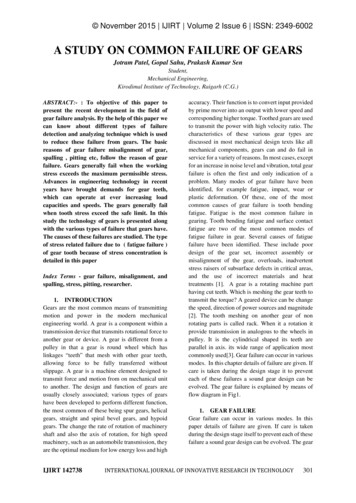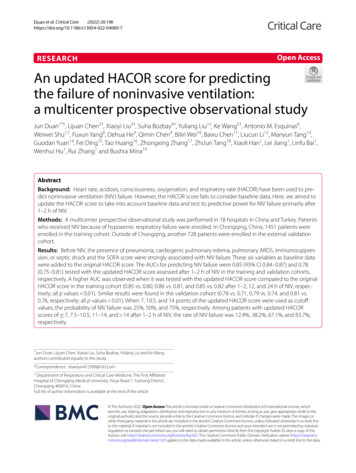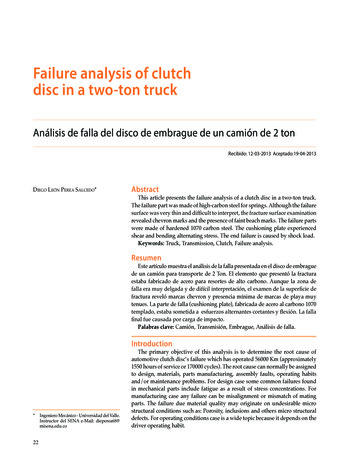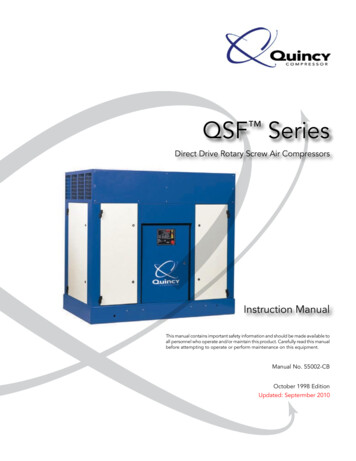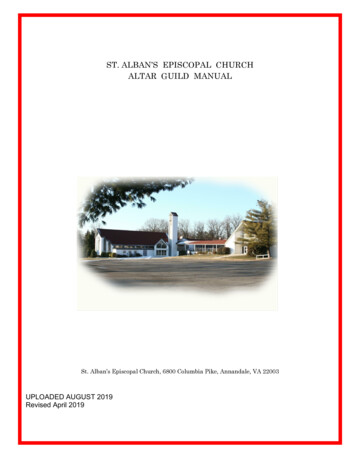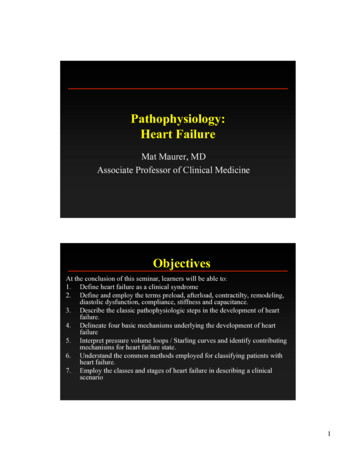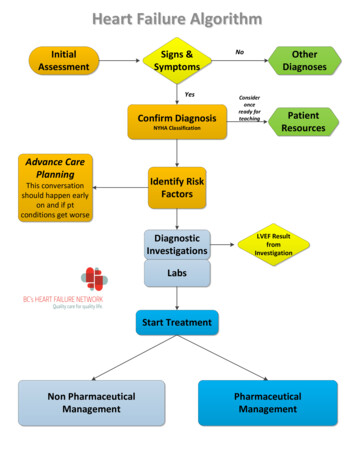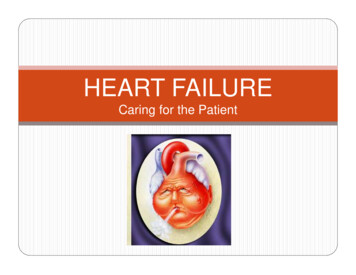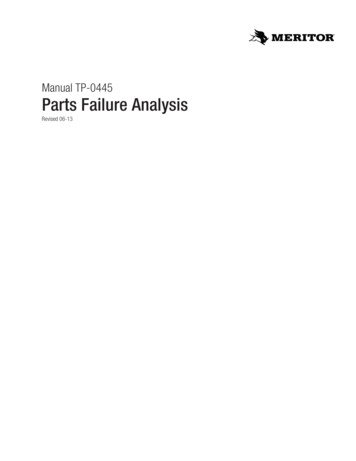
Transcription
Manual TP-0445Parts Failure AnalysisRevised 06-13
Service NotesAbout This PublicationThis publication provides a parts analysis process to help youdetermine why parts failed during operation, what to look for whenyou inspect parts, and how to help prevent failures from occurringagain.Section 1 is an overview of parts analysis, and Section 2 providesguidelines for using an investigative approach during the analysisprocess.Section 3 contains descriptions of failure types that affect parts, aswell as parts analysis terminology that’s used in the field to describeconditions that cause components to fail.Section 4, Section 5, Section 6, Section 7, Section 8, Section 9 andSection 10 include parts analysis information for the followingcomponents.Automatic Slack AdjustersBrakesDrive AxlesDrivelinesTrailer AxlesTransmissionsTransfer CasesHow to Obtain Additional Maintenance,Service and Product InformationVisit Literature on Demand at meritor.com to access and orderadditional information.Contact the OnTrac Customer Service Center at 866-668-7221(United States and Canada); 001-800-889-1834 (Mexico); or emailOnTrac@meritor.com.Information contained in this publication was in effect at the time the publication wasapproved for printing and is subject to change without notice or liability. Meritor HeavyVehicle Systems, LLC, reserves the right to revise the information presented or todiscontinue the production of parts described at any time.Meritor Manual TP-0445 (Revised 06-13)
Contentspg. i1Asbestos and Non-Asbestos FibersSection 1: Introduction to Parts Analysispg. 12Parts Analysis OverviewTypes of WearMain Causes of Premature Wear and Component Failure4Section 2: An Investigative ApproachGuidelines to an Investigative ApproachRecord Your FindingsAsk QuestionsPreparing Parts for InspectionHow to Prepare Damaged Parts for InspectionInspection Procedures for Parts AnalysisInspect Damaged Parts56789101112131416Section 3: Failure Types and TerminologyParts AnalysisBeach MarksBending Fatigue (Fatigue Fracture)Black Spots“Blue” Brake DrumBrinelling (Surface Fatigue)Burnish (Brakes)Bruising (Surface Fatigue)Chevron Wear PatternBrake CompoundingCrack-PressureCrow’s Footing (Surface Fatigue)Crystalline Wear Pattern“Drive” and “Coast” Sides of Hypoid Ring Gear TeethEtching (Surface Fatigue)Extreme Pressure (EP) AdditivesFlank Cracking (Surface Fatigue)Fatigue FractureFretting (Surface Fatigue)FrostingGalling (Surface Fatigue)Gear Ratio and Torque MultiplicationHeat CheckingHot Spotting (Black Spots)Imbalance (Brake)Impact FractureLoad CycleGross Axle Weight Rating (GAWR)Gross Vehicle Weight Rating (GVWR)Gross Vehicle Weight (GVW)Gross Combined Weight Rating (GCWR)Gross Combined Weight (GCW)171819202326272930323334Mismatched Tires (Drive Axle)Mismatched Tandem Axle RatiosNormal WearOffset FrostingOrigin PointPitting (Surface Fatigue)Premature WearRatchet MarksReverse Bending Fatigue (Fatigue Fracture)Root Beam Fatigue (Fatigue Fracture)ScoringScuffing (Galling)Shock Load (Impact Fracture)Spalling (Surface Fatigue)SpinoutStress RiserSurface (Contact) FatigueTorqueTorsional Fatigue (Fatigue Fracture)Torsional VibrationWitness MarksWorking AngleSection 4: Drive AxlesParts Analysis OverviewCommon Causes of Drive Axle Component FailuresA Vehicle is Operated Outside its Application or VocationExceeding an Axle’s Maximum Gross Axle Weight Rating(GAWR)Axle FatigueSpinoutExamples of Typical Spinout DamageShock LoadUnapproved Vehicle or Powertrain ModificationsThe Vehicle Isn’t Maintained According to Meritor’sRecommended Maintenance PracticesThe Lubricant is IncorrectContaminated LubricantLow Lubricant LevelsMetal Particles on the Magnetic Fill/Drain PlugRemove and Inspect the Magnetic Fill/Drain PlugGuidelinesCheck the Condition of the OilOil ConditionsComponents Overheat During OperationParts Analysis ProcessBearing Adjusting RingDrive Pinion Gear
Contentspg. 35363738394042434748495051525455565760Drive Pinion GearDriver-Controlled Main Differential Lock (DCDL) Shift CollarFlange-Side Main Differential BearingAxle HousingsHypoid Ring and Drive Pinion GearsHypoid Ring and Drive Pinion Gears — MX-120HR CarrierDrive Pinion Spigot Bearing — MX-120 CarrierInner Drive Pinion BearingInter-Axle Differential (IAD)Main DifferentialFlange-Side Main DifferentialPinion NutPlain-Half Differential CaseMain Differential Case-to-Case Joint SeparationPump System ScreensRear Side GearRing GearSide GearsAxle Shaft and Differential Side Gear SplineSide Gear Thrust WasherThrust WashersOil SealsSeal Test ProcedureExample 1: The Seal is not LeakingExample 2: The Seal Appears to be LeakingExample 3: The Seal is LeakingSection 5: Drivelines6364Parts Analysis OverviewEvaluate Damaged Driveline ComponentsDriveline ComponentsU-JointU-Joint FastenersDrive Shaft TubeYokesU-Joint TrunnionSplined Shaft65Section 6: Trailer Axles6162Parts Analysis OverviewEvaluate Damaged Trailer Axle ComponentsMain Causes of Trailer Axle FailureTrailer Axle68Section 7: Automatic Slack AdjustersParts Analysis OverviewEvaluate Damaged Automatic Slack AdjustersAutomatic Slack AdjusterPawl Teethpg. 69Automatic Slack AdjusterAutomatic Slack Adjuster and Camshaft Splines71Section 8: Cam and Air Disc Brakes84Parts Analysis OverviewEvaluate Damaged Brake ComponentsMain Causes of Cam and Air Disc Brake ComponentFailuresCam and Air Disc BrakesAir Disc Brakes OnlyModel ADB 1560 Air Disc Brake OnlyBrake DrumsHeat CheckingHeat Checking on Only One Side of the DrumConditions That Can Cause Failures to OccurBlack Spots (Hot Spotting) on the Drum’s SurfacePolished (Glazed) DrumScoring“Blue” DrumBroken Bolt Flange (Drum Surface Not Cracked)Broken Bolt Flange (Cracked Drum Surface)Cracked DrumWorn Brake Drum Bolt HolesOil or Grease Has Penetrated and Discolored the DrumSurfaceConditions That Can Affect Brake Drum Wear86Section 9: 103104106Parts Analysis OverviewEvaluate Damaged Transmission ComponentsCauses of Transmission FailuresParts Analysis ProcessSpur GearsRoller BearingsMain Shaft WasherMain Shaft Gear Float ClearanceGear TeethGear TeethSynchronizer PinShift Collar WearOil SealsSeal Test ProcedureExample 1: The Seal is Not LeakingExample 2: The Seal Appears to be LeakingExample 3: The Seal Appears to be LeakingExample 4: The Seal is LeakingTroubleshooting and DiagnosticsTypes of ProblemsTroubleshooting Other Systems
Contentspg. 107 Troubleshooting LeaksTroubleshooting Vibrations108 Troubleshooting Noises109 Troubleshooting Operating Conditions112 Range Shift System Diagnostics for Platform GTransmissions118Section 10: Transfer CasesParts Analysis OverviewEvaluate Damaged Transfer CaseFront Idler Bearing120 Front Output Shaftpg.
Asbestos and Non-Asbestos FibersFigure 0.1ASBESTOS FIBERS WARNINGNON-ASBESTOS FIBERS WARNINGThe following procedures for servicing brakes are recommended to reduce exposure toasbestos fiber dust, a cancer and lung disease hazard. Material Safety Data Sheets areavailable from Meritor.The following procedures for servicing brakes are recommended to reduce exposure tonon-asbestos fiber dust, a cancer and lung disease hazard. Material Safety Data Sheetsare available from Meritor.Hazard SummaryHazard SummaryBecause some brake linings contain asbestos, workers who service brakes must understand thepotential hazards of asbestos and precautions for reducing risks. Exposure to airborne asbestosdust can cause serious and possibly fatal diseases, including asbestosis (a chronic lung disease)and cancer, principally lung cancer and mesothelioma (a cancer of the lining of the chest orabdominal cavities). Some studies show that the risk of lung cancer among persons who smokeand who are exposed to asbestos is much greater than the risk for non-smokers. Symptoms ofthese diseases may not become apparent for 15, 20 or more years after the first exposure toasbestos.Accordingly, workers must use caution to avoid creating and breathing dust when servicing brakes.Specific recommended work practices for reducing exposure to asbestos dust follow. Consult youremployer for more details.Most recently manufactured brake linings do not contain asbestos fibers. These brake linings maycontain one or more of a variety of ingredients, including glass fibers, mineral wool, aramid fibers,ceramic fibers and silica that can present health risks if inhaled. Scientists disagree on the extentof the risks from exposure to these substances. Nonetheless, exposure to silica dust can causesilicosis, a non-cancerous lung disease. Silicosis gradually reduces lung capacity and efficiencyand can result in serious breathing difficulty. Some scientists believe other types of non-asbestosfibers, when inhaled, can cause similar diseases of the lung. In addition, silica dust and ceramicfiber dust are known to the State of California to cause lung cancer. U.S. and internationalagencies have also determined that dust from mineral wool, ceramic fibers and silica are potentialcauses of cancer.Accordingly, workers must use caution to avoid creating and breathing dust when servicing brakes.Specific recommended work practices for reducing exposure to non-asbestos dust follow. Consultyour employer for more details.Recommended Work PracticesRecommended Work Practices1. Separate Work Areas. Whenever feasible, service brakes in a separate area away from otheroperations to reduce risks to unprotected persons. OSHA has set a maximum allowable level ofexposure for asbestos of 0.1 f/cc as an 8-hour time-weighted average and 1.0 f/cc averaged overa 30-minute period. Scientists disagree, however, to what extent adherence to the maximumallowable exposure levels will eliminate the risk of disease that can result from inhaling asbestosdust. OSHA requires that the following sign be posted at the entrance to areas where exposuresexceed either of the maximum allowable levels:DANGER: ASBESTOSCANCER AND LUNG DISEASE HAZARDAUTHORIZED PERSONNEL ONLYRESPIRATORS AND PROTECTIVE CLOTHINGARE REQUIRED IN THIS AREA.2. Respiratory Protection. Wear a respirator equipped with a high-efficiency (HEPA) filterapproved by NIOSH or MSHA for use with asbestos at all times when servicing brakes, beginningwith the removal of the wheels.3. Procedures for Servicing Brakes.a. Enclose the brake assembly within a negative pressure enclosure. The enclosure should beequipped with a HEPA vacuum and worker arm sleeves. With the enclosure in place, use theHEPA vacuum to loosen and vacuum residue from the brake parts.b. As an alternative procedure, use a catch basin with water and a biodegradable,non-phosphate, water-based detergent to wash the brake drum or rotor and other brakeparts. The solution should be applied with low pressure to prevent dust from becomingairborne. Allow the solution to flow between the brake drum and the brake support or thebrake rotor and caliper. The wheel hub and brake assembly components should be thoroughlywetted to suppress dust before the brake shoes or brake pads are removed. Wipe the brakeparts clean with a cloth.c. If an enclosed vacuum system or brake washing equipment is not available, employers mayadopt their own written procedures for servicing brakes, provided that the exposure levelsassociated with the employer’s procedures do not exceed the levels associated with theenclosed vacuum system or brake washing equipment. Consult OSHA regulations for moredetails.d. Wear a respirator equipped with a HEPA filter approved by NIOSH or MSHA for use withasbestos when grinding or machining brake linings. In addition, do such work in an area witha local exhaust ventilation system equipped with a HEPA filter.e. NEVER use compressed air by itself, dry brushing, or a vacuum not equipped with a HEPAfilter when cleaning brake parts or assemblies. NEVER use carcinogenic solvents, flammablesolvents, or solvents that can damage brake components as wetting agents.4. Cleaning Work Areas. Clean work areas with a vacuum equipped with a HEPA filter or by wetwiping. NEVER use compressed air or dry sweeping to clean work areas. When you empty vacuumcleaners and handle used rags, wear a respirator equipped with a HEPA filter approved by NIOSHor MSHA for use with asbestos. When you replace a HEPA filter, wet the filter with a fine mist ofwater and dispose of the used filter with care.5. Worker Clean-Up. After servicing brakes, wash your hands before you eat, drink or smoke.Shower after work. Do not wear work clothes home. Use a vacuum equipped with a HEPA filter tovacuum work clothes after they are worn. Launder them separately. Do not shake or usecompressed air to remove dust from work clothes.6. Waste Disposal. Dispose of discarded linings, used rags, cloths and HEPA filters with care,such as in sealed plastic bags. Consult applicable EPA, state and local regulations on wastedisposal.1. Separate Work Areas. Whenever feasible, service brakes in a separate area away from otheroperations to reduce risks to unprotected persons.2. Respiratory Protection. OSHA has set a maximum allowable level of exposure for silica of0.1 mg/m3 as an 8-hour time-weighted average. Some manufacturers of non-asbestos brakelinings recommend that exposures to other ingredients found in non-asbestos brake linings bekept below 1.0 f/cc as an 8-hour time-weighted average. Scientists disagree, however, to whatextent adherence to these maximum allowable exposure levels will eliminate the risk of diseasethat can result from inhaling non-asbestos dust.Therefore, wear respiratory protection at all times during brake servicing, beginning with theremoval of the wheels. Wear a respirator equipped with a high-efficiency (HEPA) filter approved byNIOSH or MSHA, if the exposure levels may exceed OSHA or manufacturers’ recommendedmaximum levels. Even when exposures are expected to be within the maximum allowable levels,wearing such a respirator at all times during brake servicing will help minimize exposure.3. Procedures for Servicing Brakes.a. Enclose the brake assembly within a negative pressure enclosure. The enclosure should beequipped with a HEPA vacuum and worker arm sleeves. With the enclosure in place, use theHEPA vacuum to loosen and vacuum residue from the brake parts.b. As an alternative procedure, use a catch basin with water and a biodegradable,non-phosphate, water-based detergent to wash the brake drum or rotor and other brakeparts. The solution should be applied with low pressure to prevent dust from becomingairborne. Allow the solution to flow between the brake drum and the brake support or thebrake rotor and caliper. The wheel hub and brake assembly components should be thoroughlywetted to suppress dust before the brake shoes or brake pads are removed. Wipe the brakeparts clean with a cloth.c. If an enclosed vacuum system or brake washing equipment is not available, carefully cleanthe brake parts in the open air. Wet the parts with a solution applied with a pump-spray bottlethat creates a fine mist. Use a solution containing water, and, if available, a biodegradable,non-phosphate, water-based detergent. The wheel hub and brake assembly componentsshould be thoroughly wetted to suppress dust before the brake shoes or brake pads areremoved. Wipe the brake parts clean with a cloth.d. Wear a respirator equipped with a HEPA filter approved by NIOSH or MSHA when grinding ormachining brake linings. In addition, do such work in an area with a local exhaust ventilationsystem equipped with a HEPA filter.e. NEVER use compressed air by itself, dry brushing, or a vacuum not equipped with a HEPAfilter when cleaning brake parts or assemblies. NEVER use carcinogenic solvents, flammablesolvents, or solvents that can damage brake components as wetting agents.4. Cleaning Work Areas. Clean work areas with a vacuum equipped with a HEPA filter or by wetwiping. NEVER use compressed air or dry sweeping to clean work areas. When you empty vacuumcleaners and handle used rags, wear a respirator equipped with a HEPA filter approved by NIOSHor MSHA, to minimize exposure. When you replace a HEPA filter, wet the filter with a fine mist ofwater and dispose of the used filter with care.5. Worker Clean-Up. After servicing brakes, wash your hands before you eat, drink or smoke.Shower after work. Do not wear work clothes home. Use a vacuum equipped with a HEPA filter tovacuum work clothes after they are worn. Launder them separately. Do not shake or usecompressed air to remove dust from work clothes.6. Waste Disposal. Dispose of discarded linings, used rags, cloths and HEPA filters with care,such as in sealed plastic bags. Consult applicable EPA, state and local regulations on wastedisposal.Regulatory GuidanceRegulatory GuidanceReferences to OSHA, NIOSH, MSHA, and EPA, which are regulatory agencies in the United States,are made to provide further guidance to employers and workers employed within the United States.Employers and workers employed outside of the United States should consult the regulations thatapply to them for further guidance.iMeritor Manual TP-0445 (Revised 06-13)References to OSHA, NIOSH, MSHA, and EPA, which are regulatory agencies in the United States,are made to provide further guidance to employers and workers employed within the United States.Employers and workers employed outside of the United States should consult the regulations thatapply to them for further guidance.
1 Introduction to Parts AnalysisParts Analysis Overview1 Introduction to Parts AnalysisFigure 1.2This publication provides a parts analysis process to help youdetermine why parts failed during operation, what to look for whenyou inspect parts, and how to help prevent failures from occurringagain. Figure 1.1, Figure 1.2 and Figure 1.3 are examples of failedparts.Most of the time, you can find the answers you need by visuallyinspecting a failed component. Sometimes, however, this processmay require specialized knowledge or equipment.Also, why a product failed can be difficult to determine, because afailure can vary in appearance from vehicle to vehicle. Failures inmodels from the same manufacturer can also vary, so it’s importantto use the information presented here as a guide, not a rule, whenyou perform parts analysis inspections.4002959aFigure 1.2Figure 1.3Figure 1.14002960aFigure 1.3Types of Wear4002958bFigure 1.1Normal WearComponents that are operated correctly, and inspected andmaintained at recommended intervals, will eventually wear undernormal operating conditions. This is called “normal” wear.Premature WearComponents can wear prematurely and fail when a vehicle isoperated under the following conditions.Meritor Manual TP-0445 (Revised 06-13)1
1 Introduction to Parts AnalysisMain Causes of Premature Wear andComponent FailureA Vehicle is Not Maintained CorrectlyA Vehicle is Not Operated Correctly, or is OperatedAbusivelyWhen a driver doesn’t operate a vehicle correctly, or operates itabusively, components can fail immediately. Often, however,damaged components will continue to operate, but fail at a latertime — even under normal operating conditions.For example, when a driver speeds up the engine and rapidlyreleases the clutch (“popping the clutch”), or allows a vehicle’sspinning wheel to hit dry pavement, it causes an immediate load, orforce, to the driveline. Component failure can occur immediately, orat a later time. Figure 1.4 and Figure 1.5.Premature wear and damage to components will result if a vehicle isnot correctly maintained according to Meritor’s recommendedmaintenance intervals and lubricant specifications. For example, thelubricant is not specified by Meritor; the lubricant is contaminated;or there’s insufficient lubricant or no lubricant at all in the system.For example, lubricant contaminated with water, dirt or wearparticles will damage the mating surfaces of components,particularly bearing surfaces. Other areas of concern are seals andbreathers. Figure 1.6.Figure 1.6Oil level must be even withbottom of fill plug hole.Figure 1.4FILL PLUG4004598a4004601aFigure 1.4Figure 1.6Figure 1.5A Vehicle is Operated Outside Application,Equipment and Load Limits Approved by MeritorComponents must be operated within the application guidelinesspecified by Meritor. Otherwise, Meritor must approve applicationsfor vehicles operated outside these e 1.52Meritor Manual TP-0445 (Revised 06-13)Meritor has four application types: linehaul, general service, heavyservice and restricted service. The descriptions in the table beloware typical for these types.
1 Introduction to Parts AnalysisTable AApplicationMiles Per YearOperating ConditionsLinehaulHigh mileage/over 60,000A vehicle operates on well-maintained major highways of concreteor asphalt construction with greater than 30 miles between startingand stopping.General ServiceLess than 60,000A vehicle operates mostly on-road (less than 10% off-road) andaverages two stops and starts per mile.Heavy ServiceLess than 60,000A vehicle operates both on- and off-road (10% or more off-road)with moderate-to-frequent stops and starts that average up to 10stops per mile.Restricted ServiceLow mileageUsually these vehicles are not licensed for highway use, arerestricted to 15 mph, and average six stops and starts per mile.Meritor Manual TP-0445 (Revised 06-13)3
2 An Investigative ApproachGuidelines to an InvestigativeApproach2 An Investigative ApproachWhen you visually inspect damaged components, a common erroryou can make is to assume the first damaged component you find islikely responsible for the failure. However, it’s important toremember that instead of being the cause of the failure, thedamaged component actually may be the result of the failure.A positive way to conduct a failure analysis inspection is to use aninvestigative approach. Here are guidelines that will help you toperform a failure analysis inspection.Record Your FindingsBefore you begin, be prepared to record all the results you obtainfrom asking questions, and observing and inspecting damagedparts.What were the vehicle’s static and dynamic loading conditions? Isthere evidence of cyclic loading or torsional vibration?Was the vehicle maintained correctly? Check the vehicle’s serviceand maintenance logs, as well as the types and brands of greaseand oil used. Are the lubricants the correct specification approvedby Meritor?Check the vehicle’s overall condition. Look for grease and oil leaks.Look for signs of abuse and recent repair. Check tire wear. Wherepossible, remove inspection plates, access doors and top covers tofind potential component damage in these areas.Is the vehicle covered with mud? Does it look as if it’s recently beenpowerwashed? If so, the vehicle may have been operated in anapplication that wasn’t approved by Meritor.Is the vehicle equipped with a lift axle, and was it in use at the timeof the failure? Does the vehicle have multiple retarders?Ask QuestionsPreparing Parts for InspectionTry to Speak to People Who Can Help with YourInvestigationHow to Prepare Damaged Parts forInspectionTry to speak to the vehicle’s operator, the driver who recovered thevehicle, and the repair technician. If an accident occurred, try to talkto those people knowledgeable about the circumstances. A personwho’s witnessed the failure can provide important information, butit’s important to listen objectively to all reports.About Damaged PartsDid components fail over time or instantaneously? Werecomponents stressed by cyclic overload?What component or part failed first? Was the failure a result of avehicle system failure? What’s the torque rating of the componentthat failed?Was the component repaired recently? Can you speak to thetechnician who repaired the component?Verify the weather and road conditions at the time of the failure. Wasthe vehicle involved in an accident? If so, can you see the accidentreport or talk to witnesses?About the VehicleDetermine if the vehicle was towed or driven to a garage for repair.Was it connected to a trailer, or had the vehicle just been connectedto a trailer?What’s the vehicle’s in-service date and application type?Verify the vehicle’s application and length of service. Check thevehicle’s mileage.4Meritor Manual TP-0445 (Revised 06-13)Don’t clean parts before you inspect them. Parts should be left intheir failed condition and position. If possible, the parts shouldremain with the vehicle; and if outdoors, protected from rain,contaminants, sand, etc.Inspection Procedures for PartsAnalysisInspect Damaged PartsCollect the damaged parts. This includes Meritor components, aswell as those from other manufacturers. Assemble components intotheir original working order.If there’s only one failure point or damaged component, begin theinspection there. If there’s more than one, inspect each componentindividually.Inspect the areas around components. Try to determine the failuretype. Was it surface or fatigue fracture? Shock load? Was the failurecaused by insufficient lubrication or an incorrect lubricant? Was thefailure caused by spinout?Thoroughly inspect components for witness marks that can giveclues to why a component failed. Check for signs of vehicle abuse.When you’re inspecting a gear box that’s still assembled, check theend play, backlash, tooth contact pattern, runout, etc.
3 Failure Types and TerminologyParts Analysis3 Failure Types and TerminologyThis section provides descriptions of part failure types, as well asparts analysis terminology that’s used in the field to describeconditions that cause components to fail.Beach MarksBending fatigue also causes gears to change position, which affectstooth contact patterns. Figure 3.3 shows concentrated loading atgear teeth corners instead of over the entire surface. Figure 3.4shows two tooth patterns on the ring gear, because bending fatiguecaused the gear to change position.Figure 3.2Beach marks result from a fatigue fracture and indicate theprogressive positions of an advancing fracture. Beach marks appearas irregular curved rings that radiate from one or more origins.They’re typically found on fractures caused by periodic or prolongedstress from load applications.Beach marks represent fatigue cycles that occurred before thecomponent failed completely. Visually, beach marks are oftencompared to the rippling effect of a stone thrown into calm water.Figure 3.1.Figure 3.1PROGRESSIVEFLAT FATIGUEFRACTURE WITHCURVED BEACHMARKSSHEAR LIP(SLANT FRACTURE)FASTOVERLOADFRACTUREORIGIN 14004529a123RATCHETMARKPOINT OF ORIGINBEACH MARKSFINAL FRACTUREFigure 3.2ORIGIN 24005188aFigure 3.1Bending Fatigue (Fatigue Fracture)Bending is a type of fatigue fracture that occurs when a shaft issubjected to both torsional and bending fatigue at the same time.Beach marks form and usually point toward the origin of thefracture, which represents fatigue fracture cycles that occurredbefore the component failed completely. Figure 3.2 shows beachmarks on an axle shaft that indicate it fractured as a result ofbending fatigue.Meritor Manual TP-0445 (Revised 06-13)5
3 Failure Types and TerminologyFigure 3.5 shows what happens when parts are under bendingfatigue. When the load is large, failure can occur within a few loadcycles. As the load becomes smaller, more load cycles are requiredbefore failure will occur. When the load becomes even smaller, thepart can withstand load cycles without damage. Also refer toReverse Bending Fatigue in this section.Figure 3.3Figure 3.5BENDING/TORSIONAL FATIGUELARGEBREAKDOWN LINELOADENDURANCE LIMITSMALLFEWMANYNUMBER OF CYCLES4004584a4004572aTEETH BROKEN DUE TO FATIGUE AT HEEL ENDFigure 3.5Figure 3.3Black SpotsRefer to Hot Spotting in this section.Figure 3.4“Blue” Brake DrumVery high operating temperatures can cause the inside of the brakedrum to turn a blue color, which usually indicates that the drum isdamaged.Brinelling (Surface Fatigue)Brinelling is a type of surface fatigue that causes bearing rollers towear deep grooves into the mating surface. Figure 3.6. Brinelling ofa u-joint usually occurs when load applications exceed the vehicle’srating, which can also cause parts to spall from uneven loadapplication.4004573a12ORIGINAL PATTERNSECONDARY PATTERNFigure 3.46Meritor Manual TP-0445 (Revised 06-13)
3 Failure Types and TerminologyFigure 3.6Figure 3.74004560a4002965aThis trunnion has severe brinelling. The roller bearings have worndeep grooves that are easily detectable by touch.Figure 3.6Brinelling can also be caused by overloads on undersized u-jointsand by a breakdown of lubricant between the needle rollers andtrunnion. To determine if the condition you see is brinelling, checkthe trunnions with your fingertips. Do you feel deep grooves? If so,brinelling has occurred.“False” brinelling, also a type of surface fatigue, causes the needlerollers to polish the trunnion surface, unlike brinelling, which causesthe rollers to wear deep grooves into the trunnion surface. Todetermine if the condition is “false” brinelling, check the trunnionwith your fingertip. Do you feel deep grooves? If not, the condition is“false” brinelling, the trunnion isn’t damaged and the u-joint is stillusable.Burnish (Brakes)The process of “breaking-in” new brake pads or shoes, so thelinings conform to the disc or drum friction surfaces.Bruising (Surface Fatigue)Bruising is a type of surface fatigue that’s similar to brinelling, whichcauses dents in a metal surface. Metal chips or large particles of dirtcirculate in the lubricant and become trapped between the bearingcone, cup and rollers. Figure 3.7.Figure 3.7Chevron Wear PatternA chevron pattern contains V-shaped radial marks on a brittlefracture surface, usually on parts whose widths are considerablygreater than their thickness. Also called a herringbone pattern, thepoints of the chevrons identify a fracture’s path by pointing towardits origin. A chevron pattern is easily visible as a result of aninstantaneous failure, but you can see them on some fatigue failuresas well. Figure 3.8.Figure 3.84005193aFigure 3.8
Section 3 contains descriptions of failure types that affect parts, as well as parts analysis terminology that's used in the field to describe conditions that cause components to fail. Section 4, Section 5, Section 6, Section 7, Section 8, Section 9 and Section 10 include parts analysis information for the following components.
